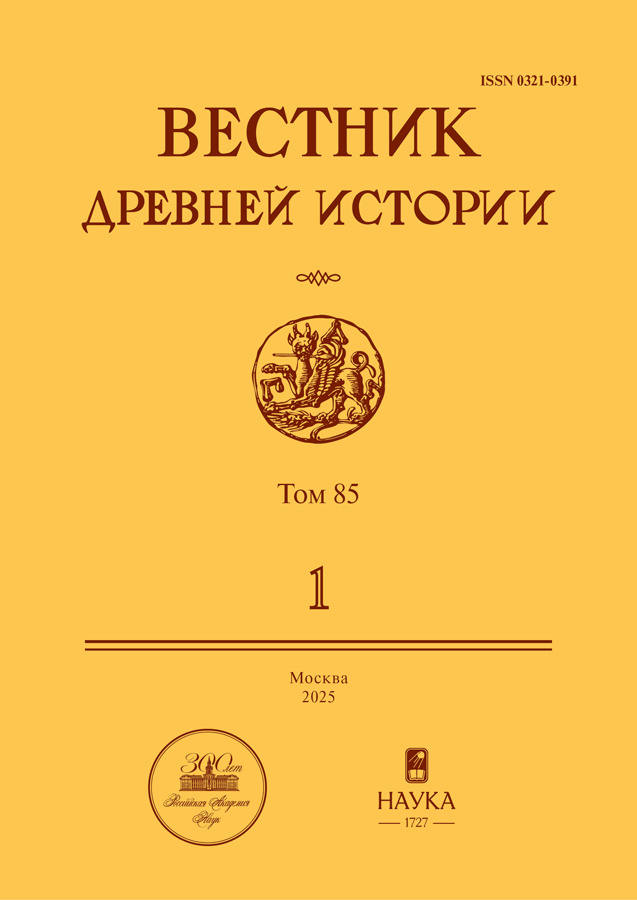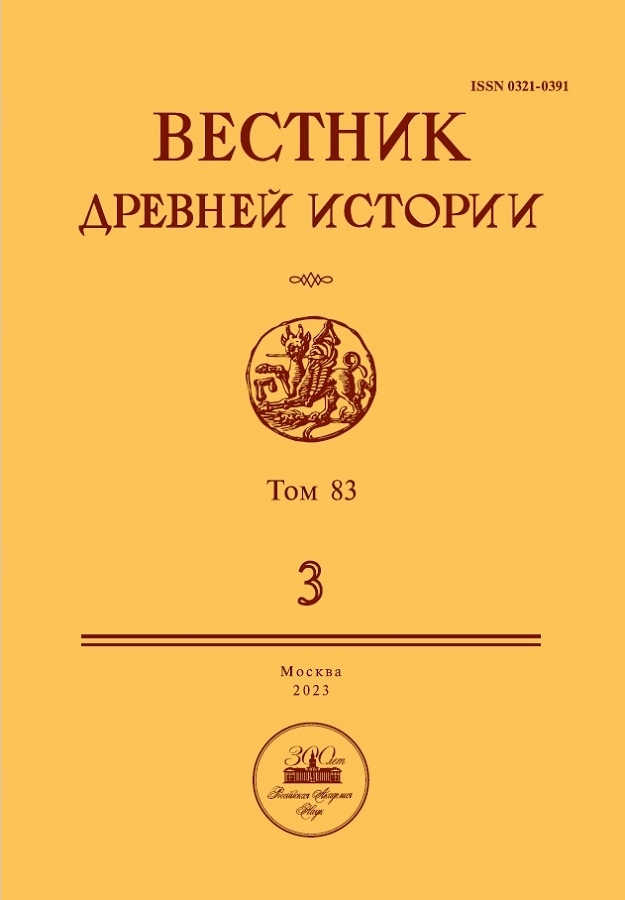Том 83, № 3 (2023)
Статьи
Аспекты теологической категории бессмертия в позднеегипетской религии
Аннотация
Данная часть исследования египетской эсхатологической фразеологии содержит лексикографический и контекстуальный комментарий к эпитету Хора Бехдетского n mrH=f «бессмертный» (Dendara IX, 152.15) и имеет цель выявить истоки теологической категории бессмертия в позднеегипетской религии. Эпитет n mrH=f «бессмертный» произведен от отрицательного обстоятельственного предложения с инфинитивом n mrH «непрерывно» / «не истлевая», которое рассматривается в двух аспектах: 1. n mrH «непрерывный» как характеристика a) непрерывного процесса или b) повторения события в циклическом режиме. 2. n mrH «нетленный» как отрицание физического уничтожения трупа или души покойного. Эпитет n mrH=f «бессмертный» эквивалентен форме jwtj mrH «беспрерывный», и в нем бессмертие божества характеризуется через отрицание хронологического аспекта бытия бога. Теологическое доказательство постоянства бога апофатическим методом инвертировало мифологические описания, противопоставив субстанцию бога как остановившееся время гибельному процессу вечности.
Вестник древней истории. 2023;83(3):515-538
 515-538
515-538


Шлем Диодота Трифона: опыт нумизматического и археологического исследования
Аннотация
В статье проводится археологический и нумизматический анализ изображения парадного царского шлема, помещенного на монетах селевкидского узурпатора середины II в. до н.э. Диодота Трифона. Наличие археологических аналогий отдельным элементам конструкции «шлема Трифона» позволяет сделать вывод о существовании реального царского шлема, послужившего прототипом для монетного изображения данной серии. Иконографически «шлем Трифона» представляет собой композит, включающий македонские и дионисийские мотивы. Принимая во внимание политический контекст эпохи, стоит признать, что рассматриваемый «шлем Трифона» являлся не только ярким примером эллинистического парадного вооружения, но и важнейшим инструментом легитимации власти узурпатора, которая покоилась на лояльности военных элит Апамеи на Оронте.
Вестник древней истории. 2023;83(3):539-555
 539-555
539-555


Политическая позиция Гая Атея Капитона, плебейского трибуна 55 г. до н. э.
Аннотация
В статье рассматривается гипотеза о сотрудничестве плебейского трибуна 55 г. до н.э. Гая Атея Капитона с Цезарем, выдвинутая независимо друг от друга Е.В. Смыковым и П. Буонджорно. Рассмотрена политическая позиция Атея в год его трибуната и на следующих этапах его карьеры, в том числе проблематичные свидетельства, относящиеся к 54 и 52 гг. до н.э., цензорское замечание, полученное Атеем в 50 г. до н.э., ходатайство Цицерона в защиту интересов Атея в 46 г. до н.э и участие последнего в бутротской земельной комиссии в 44 г. до н.э. Сделан вывод об обоснованности традиционной точки зрения, согласно которой в 55 г. до н.э. Атей был сторонником Катона, а на сторону Цезаря перешел не ранее 50 г. до н.э. Показано, что Атей не оказывал Цезарю важных услуг, а его включение в земельную комиссию не следует расценивать как знак расположения к нему Цезаря.
Вестник древней истории. 2023;83(3):556-575
 556-575
556-575


Цезарь, Каппадокия и Малая Армения
Аннотация
После завершения Александрийской кампании Цезарь, проходя летом 47 г. до н.э. через Каппадокию, передал брату царя Ариобарзана Ариарату какую-то территорию, о чем свидетельствуют «Записки об Александрийской войне». Тем не менее смысл этого распоряжения неясен, поскольку часть текста источника утрачена, и в историографии проблема остается нерешенной. В статье на основании анализа текста самого источника и его сопоставления со сведениями других исторических источников предпринята попытка прояснить данный вопрос. Как было установлено, в утраченном фрагменте текста содержалась, вероятно, информация о передаче Цезарем Ариарату части Малой Армении. Полученные результаты позволяют реконструировать политику Цезаря в отношении Каппадокии, Малой Армении и одного из тетрархов галатов Дейотара в 47 г. до н.э., а также проясняют логику самого текста «Александрийской войны».
Вестник древней истории. 2023;83(3):576-592
 576-592
576-592


Самопродажа ad actum gerendum в классическом римском праве
Аннотация
Ульпиан (10 ad Sab.: D. 28. 3. 6. 5) упоминает самопродажу ad actum gerendum (т.е. с целью ведения дел другого лица в качестве управляющего) наряду с самопродажей ad pretium participandum (т.е. с целью получения части цены) как causa servitutis, приводящую к утрате римлянином гражданских прав. По мнению автора, самопродажа ad actum gerendum, как и ad pretium participandum, представляла собой особую мошенническую схему, предпола-гавшую обогащение самопродавшегося за счет обманутого покупателя, с момен-та покупки – его мнимого господина (присвоение мнимым рабом денег, которые он нажил втайне от хозяина, управляя его имуществом), и положительный для мошенника исход процесса о свободе (causa liberalis). Защита обманутого поку-пателя посредством исков в данном случае оказывалась неэффективной, и по-этому, чтобы воспрепятствовать реализации преступной схемы и покарать зло-умышленника, мнимому господину как ответчику в causa liberalis стали предо-ставлять исковое возражение emptionis atque actus administrati, приводившее к denegatio proclamationis мнимого раба, лишавшей его возможности отстаивать свою свободу в ходе судебного разбирательства, и, таким образом, он становил-ся «рабом де-факто», который приравнивался к подлинному рабу.
Вестник древней истории. 2023;83(3):593-605
 593-605
593-605


Клад тетрадрахм митридатовского времени из Херсонеса
Аннотация
В статье публикуется клад из 119 тетрадрахм и драхм митридатовского времени, обнаруженный на ближней хоре Херсонеса Таврического в 2013 г. Основу клада составляют тетрадрахмы Митридата VI (79 экз.), к которым подмешаны тетрадрахмы царей Вифинии Никомеда II и Никомеда III (3 экз.), поздние тетрадрахмы лисимаховского типа чеканки Византия (17 экз.), афинские тетрадрахмы нового стиля (2 экз.). Кроме 101 тетрадрахмы клад включает 18 драхм царей Каппадокии: Ариарата VII, Ариарата VIΙI, Ариарата IX, Ариобарзана Ι. В кладе встречаются тетрадрахмы Митридата VI с неизвестными ранее датами. Самая поздняя из драхм Ариобарзана Ι (65/64 г. до н.э.) свидетельствует о том, что комплекс сложился после прибытия Митридата на Боспор и бегства Махара в Херсонес. Более четверти митридатовских тетрадрахм составляют новые монеты последнего года чеканки, без следов обращения, в «штемпельном блеске», большей частью отчеканенные одними и теме же штемпелями аверса или общими штемпельными парами. Этот факт определенно свидетельствует о централизованной выдаче серебра из царской казны. Клад был сокрыт скорее всего во время антимитридатовского восстания в Херсонесе в 63 г. до н.э.
Вестник древней истории. 2023;83(3):606-619
 606-619
606-619


Новая надпись с поселения Каменная батарейка на Азиатском Боспоре
Аннотация
В статье публикуется надгробная надпись, нанесенная на стелу, которая была обнаружена в 2015 г. на поселении Каменная батарейка (Азиатский Боспор). Стела использована вторично – относящийся к первому использованию рельеф сбит. Надгробие поставлено для Аполлония, сына Омпсалака, его братом Патасием. В статье разбираются упомянутые в надписи имена Омпсалак (сарматское) и Патасий (египетское). Семья Омпсалака имела, видимо, сарматское происхождение, но ко II–III вв., когда была установлена надпись, она уже была сильно эллинизирована. Надпись дополняет имеющиеся данные о присутствии в составе греческого населения Боспора, в том числе его сельской территории, элемента сарматского происхождения.
Вестник древней истории. 2023;83(3):620-631
 620-631
620-631


Керамика из археологического комплекса Хор-Дауд (Египет) в собрании ГМИИ им. А.С. Пушкина: новые данные
Аннотация
В статье публикуются и анализируются шесть керамических сосудов, найденные Нубийской экспедицией АН СССР в 1962 г. на памятнике Хор-Дауд (Южный Египет) и впоследствии переданные в коллекцию ГМИИ им. А.С. Пушкина в Москве. Четыре сосуда являются египетскими по облику и характерны для археологической культуры Нагада, другие два можно охарактеризовать как нубийские; датировка этой группы керамики вписывается в интервал Нагада IIB–IIIA (3600–3200 гг. до н.э.). Учитывая характер находок, памятник Хор-Дауд, входящий в ареал археологической культуры группы А, следует интерпретировать как торговую факторию, где производился обмен товарами, поступавшими из Египта, региона среднего течения Нила и Нубийской пустыни.
Вестник древней истории. 2023;83(3):632-656
 632-656
632-656


Проблемы периодизации и принципы выделения этапов истории древности в отечественной науке ХХ–XXI вв. Часть 2
Аннотация
Во второй части статьи рассматриваются принципы постулирования в позднесоветской науке 1960–1980-х годов крупных периодов древней истории: выделение по экономическому признаку эпох крупных централизованных хозяйств (III тыс. до н.э.), парцеллярных хозяйств на государственной земле (II тыс. до н.э.), «приватизации экономики» (I тыс. до н.э.); выявление значимых тенденций духовной жизни на этапе «осевого времени» и конца древности; учет новых этнологических и археологических подходов в характеристике политогенеза. Можно констатировать фактическое прекращение разработки теоретических проблем истории древности в постсоветское время. В перспективе исследования рубежей древней истории необходимо выделить значимость определяющих их индустрийных, климатических и миграционных факторов, а также факторов, повлиявших на изменение мировоззренческой ситуации в осевое время. Финал древней истории, по-видимому, зависел не столько от внутренней эволюции самих древних обществ, сколько от ряда ударов, обрушившихся на них извне.
Вестник древней истории. 2023;83(3):657-682
 657-682
657-682


 683-689
683-689


 690-699
690-699


 700-706
700-706


 707-709
707-709


 710-714
710-714


 715-719
715-719


 720-721
720-721


 722-724
722-724


 725-754
725-754













